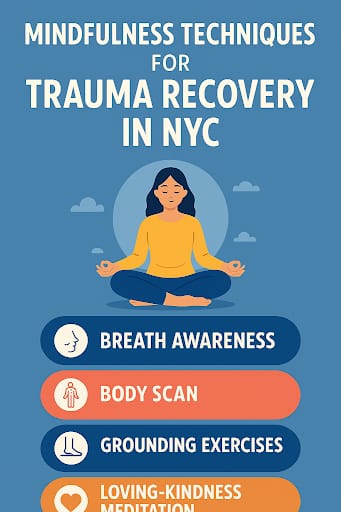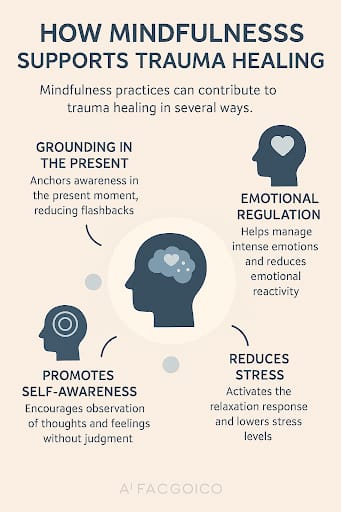
INTRODUCTION
Do you feel trapped in painful memories or frequently overwhelmed by emotions that feel completely out of your control? Trauma can leave lasting emotional scars that remain well after the trauma is over.
But, there is hope for recovery – and mindfulness is a key to recovery. Mindfulness techniques are useful for re-establishing contact with the present moment and its help to quiet the nervous system and create an opportunity to process trauma without judgment.
Whether you are partially or fully stuck in anxiety, flashbacks, or feeling numb, practicing mindfulness is an effective intervention on the road to recovery. This blog explores the practical mindfulness techniques that can support your healing from traumatic events.
Understanding Trauma: Why Mindfulness Matters
Trauma is a severely upsetting emotional reaction to overwhelming experiences such as physical abuse, emotional neglect, accidents, violence, or pervasive chronic stress.
- These experiences can destroy an individual’s sense of safety and control and produce long-term emotional and physiological consequences.
- Even years later, trauma can resurface in the form of flashbacks, anxiety, dissociation, nightmares, and chronic illness.
From a neurological perspective: trauma changes how the body triggers stress. The amygdala becomes hyperactive (what is that? – it detects danger) and the prefrontal cortex goes suppressed (logical thinking, decision-maker), which creates a permanent “fight, flight or freeze” response.
Mindfulness offers a powerful path to healing because it explains their is no threat and gives someone information to stay in the moment.
- It emphasises reconnection to one’s mind and body, should support emotion regulation, and calm hyper-vigilance while creating space between triggers and reaction.
- By working on their mindfulness practice daily, one can also develop renewed neuroplasticity when practicing trauma recovery.
Many trauma therapists in NYC teach some form of a mindfulness technique in therapy sessions, since it is one way to calm the nervous system and increase trauma recovery resilience.
How Mindfulness Supports Trauma Healing

Mindfulness plays a crucial role in trauma healing by gently rewiring our body and mind interaction with stress.
- One powerful aspect of mindfulness is its ability to regulate the nervous system. Mindfulness dampens the over-activity of the amygdala (the brain’s fear center), while improving functioning in the prefrontal cortex promoting emotional regulation and decision making capacities.
- Mindfulness also builds emotional resilience by encouraging an individual to sit with unpleasant emotions while distinguishing them from “bad” emotions with judgement, rather than avoiding or being submerged by them and discovering inner strength and self-compassion.
- Mindfulness also enhances interoception or awareness of internal body sensations as trauma often distorts this experience.
- Survivors begin to reconnect to their body, noticing subtle internal signals indicative of changes in their breath or muscle tension.
- Finally mindfulness helps to bring awareness back to the present moment, which helps to interrupt unrelenting ruminative cycles, and can lessen the emotional intensity of flashbacks.
In these ways, mindfulness can be a very effective and supportive mechanism in a trauma recovery journey.
Mindfulness Techniques for Trauma Recovery
1. Grounding Techniques
Grounding exercises with the five senses is an easy but effective mindfulness practice to bring you back to the present moment. Grounding is an effective mindfulness practice to reconnect to now when you are feeling dissociated or experiencing heightened anxiety.
By engaging with your senses, you take the attention away from distressing thought and back into your body in the physical world. You will identify 5 things you see, 4 things you can feel or touch, 3 things you can hear, 2 things you can smell, and 1 thing you can taste.
Grounding in the senses, allows you to anchor yourself in the here and now, as it words to bring safety and stability to the body and mind. Trauma therapists in NYC often have their clients ground themselves before they engage in deeper emotional processing.
2. Body Scan Meditation
Body scan meditation is a mindful practice that enables you to reconnect with your body and brings about deep relaxation.
- To practice, first find a comfortable sitting or lying posture and close your eyes.
- Take a deep breath, inhaling deeply and exhaling slowly, to ground yourself.
- Then, gradually channel your attention and awareness beginning with your feet and moving up through your whole body while noting any sensations, as they arise, (e.g., tension, warmth, tingling, numbness), with frankness, without judgment or attempt to change anything.
- If your mind wanders, simply return your attention to the body.
- Start with 5 to 10 minutes, but feel free to increase that as you get more comfortable with the practice.
You will become more aware of yourself as a whole being and, despite the attention and focus, feel a calming sense of presence.
3. Mindful Breathing
Mindful breathing is a powerful grounding exercise, particularly useful when experiencing flashbacks, anxiety, or emotional distress.
- To begin, find a comfortable position in sitting or lying down, and bring your attention to the sensory experience of your breath moving in and out through your nose or belly.
- You may find that silently repeating phrases like, “Inhale, I am safe. Exhale, I release.” helps you focus as you watch your breath.
- When distracting thoughts emerge, simply notice them with kindness and without judgment and redirect your focus back to the breath.
- Of course, remembering that your breath is your anchor, and is always there in the moment with you, really grounds you in the moment and reminds you that you are alive, safe, and capable of healing.
4. Loving Kindness Meditation (Metta)
Loving-kindness Meditation, also referred to as Metta, is a healing practice that builds compassion-which is essential for trauma survivors who struggle with self-blame, shame, and isolation.
- To start, find a quiet place to sit, then think of someone you care about dearly.
- Silently repeat phrases that radiate gentleness-like, “May you be safe. May you be healthy. May you live with ease.”
- After sending goodwill to this person, start to slowly intend those notions toward yourself, “May I be safe. May I be healthy. May I live with ease.”
- This can feel difficult if you carry guilt or shame; however, if you begin with someone easy to love, this can begin to build self-compassion.
As you practice Metta meditation, over time, you should slowly notice that you are able to soften your emotional wounds as well as sometimes hearing your own voice to be kind and supportive to yourself, for your own peace.
5. Mindful Journaling
Mindful journaling is a reflective practice that assists with emotional processing and encourages healing through self-expression in a safe environment.
- Allow yourself to write for 10-15 minutes a day without editing or judgment. You may be surprised by what you discover about yourself, the relief you feel, and the insights you gain.
- Some prompts to help you engage with your emotions more deeply might include: “What am I feeling right now?”; “Where do I feel this in my body?” This mindful practice allows your trauma story to be reflected on gently, while allowing you to learn without losing clarity.
- You can map your emotional growth or progression over time.
Tips for Trauma-Sensitive Mindfulness Practice
Mindfulness can be a useful resource for healing trauma, but it is important to practice with care and sensitivity.
- You may want to practice 2-5 minutes at first, as you get used to the experience.
- You might also want to create a calming and protected environment to help you feel more grounded, such as a quiet room with soft music or calming scents.
- Some people may benefit from movement-based practices or open eyes, instead of standard close-eyed meditation.
- Always pay attention to your body. If your practice becomes overwhelming, stop or pause.
You might find it helpful to work with a trauma-informed therapist or group.
Final Thought
Mindfulness is a very effective tool to help trauma survivors toward emotional healing and inner peace. Whether you practice using grounding, breath work, meditation, or journaling, all mindfulness tools will help soothe the nervous system, connect the mind and body, and create a safe space for emotional healing.
- It is important to be mindful of your practice and be consistent and gentle with yourself, and having support with a trauma-informed therapist in NYC can provide the boundaries and safety that many people need.
- Remember that healing takes time, and mindfulness in each moment brings you closer to resilience, self-compassion, and taking your life back from trauma.
Reference
- Boyd, J. E., Lanius, R. A., & McKinnon, M. C. (2017). Mindfulness-based treatments for posttraumatic stress disorder: A review of the treatment literature and neurobiological evidence. Journal of Psychiatry & Neuroscience : JPN, 43(1), 7. https://doi.org/10.1503/jpn.170021
- Kachadourian, L. K., Harpaz-Rotem, I., Tsai, J., Southwick, S., & Pietrzak, R. H. (2021). Mindfulness as a Mediator between Trauma Exposure and Mental Health Outcomes: Results from the National Health and Resilience in Veterans Study. Psychological Trauma : Theory, Research, Practice and Policy, 13(2), 223. https://doi.org/10.1037/tra0000995
- “Trauma.” American Psychological Association, https://www.apa.org/topics/trauma/
- Bremner, J. D. (2006). Traumatic stress: Effects on the brain. Dialogues in Clinical Neuroscience, 8(4), 445. https://doi.org/10.31887/DCNS.2006.8.4/jbremner
- Müller-Engelmann, M., Bahnemann, L., & Kümmerle, S. (2024). The effects of a combination of cognitive interventions and loving-kindness meditations (C-METTA) on guilt, shame and PTSD symptoms: Results from a pilot randomized controlled trial. European Journal of Psychotraumatology, 15(1), 2308439. https://doi.org/10.1080/20008066.2024.2308439






